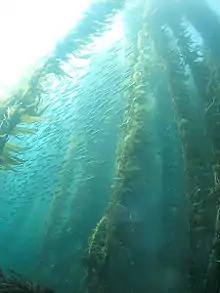Marine permaculture
Marine Permaculture is a form of mariculture that reflects the principles of permaculture by recreating seaweed forest habitat and other ecosystems in nearshore and offshore ocean environments. Doing so enables a sustainable long-term harvest of seaweeds and seafood, while regenerating life in the ocean.

Marine Permaculture was created by Dr. Brian von Herzen and colleagues at the Climate Foundation[1] then in Woods Hole, Massachusetts and now in Seattle, Washington.
Macroalgae ecosystems restoration
Marine Permaculture comprises a platform from which seaweed ecosystems can be grown, creating the environmental conditions for primary production and habitat for marine life. Using a system of renewably powered pumps, cool, nutrient-rich waters are brought up from a depth of 100-500 meters, below the nutricline, to the ocean surface, thereby replicating natural overturning circulation processes of ocean upwelling and mitigating against marine heatwaves that have led to ocean stratification and decimated natural macroalgae ecosystems in many regions of the world.[2][3][4] In addition, artificial structures provide substrate seaweeds require to grow on. The seaweed growth and increased plankton provide critical marine habitat for fish populations to thrive.[5] This type of intervention regenerates overturning circulation and returns mixed layer temperatures to levels closer to those measured pre-industrially.
Ocean regeneration potential
Marine Permaculture has received endorsement from a number of permaculture experts, including Morag Gamble of the Permaculture Education Institute,[6] Matt Powers,[7] David Holmgren and the Santa Barbara Permaculture Network,[8] who have recognised its adherence to the principles of permaculture. It has also received considerable attention as a potentially ground-breaking climate solution.[9] It has featured as a “Coming Attraction” solution in the book Drawdown: The Most Comprehensive Plan Ever Proposed to Reverse Global Warming edited by Paul Hawken and was one of the main climate solutions featured in Damon Gameau’s documentary film 2040. Professor Tim Flannery has also highlighted Marine Permaculture’s potential in sequestering gigatons of carbon through hectare scale platforms in the open ocean,[10][11][12][13] an idea that has also received attention from the voluntary carbon market Nori.[14][15] Marine Permaculture is also mentioned as a climate solution in Burn: Using Fire to Cool the Earth by Albert Bates and Kathleen Draper.[16] Marine Permaculture also features in the MacArthur Foundation's Bold Solutions Network, of the “Top100” innovative solutions to the world’s most pressing challenges.[17]
Product applications
If deployed at scale, it has the potential to provide food security to billions of people who rely upon the oceans for their primary source of protein, act as a source of blue carbon, while lowering ocean acidification, providing sustainable livelihoods, and restoring marine habitat. To date, Marine Permaculture trials have been conducted in numerous regions of the world including Hawaii, the Philippines, Puerto Rico and Tasmania, where it is being used to regenerate seaweed ecosystems recently decimated from climate change.[18][19][20] Harvesting organic kelp may produce ingredients for agriculture, fertilisers, pharmaceutical and textiles: Biostimulants, such as organic soil immprovers, feed supplements for fish and cattle, pulp for cellulose, fibers to replace wood pulp, nanocellulose for water-proofing cardboards, and biomedical molecules with natural anti-septic properties are some of the products elaborated by the marine permaculture projects.
References
- "Climate Foundation". Climate Foundation. Retrieved 2022-03-06.
- Thomsen, Mads S.; Mondardini, Luca; Alestra, Tommaso; Gerrity, Shawn; Tait, Leigh; South, Paul M.; Lilley, Stacie A.; Schiel, David R. (2019). "Local Extinction of Bull Kelp (Durvillaea spp.) Due to a Marine Heatwave". Frontiers in Marine Science. 6. doi:10.3389/fmars.2019.00084. ISSN 2296-7745. S2CID 69173935.
- Straub, Sandra C.; Wernberg, Thomas; Thomsen, Mads S.; Moore, Pippa J.; Burrows, Michael T.; Harvey, Ben P.; Smale, Dan A. (2019). "Resistance, Extinction, and Everything in Between – The Diverse Responses of Seaweeds to Marine Heatwaves". Frontiers in Marine Science. 6. doi:10.3389/fmars.2019.00763. ISSN 2296-7745. S2CID 209324664.
- Wernberg, T.; Bennett, S.; Babcock, R. C.; de Bettignies, T.; Cure, K.; Depczynski, M.; Dufois, F.; Fromont, J.; Fulton, C. J.; Hovey, R. K.; Harvey, E. S. (2016-07-08). "Climate-driven regime shift of a temperate marine ecosystem". Science. 353 (6295): 169–172. Bibcode:2016Sci...353..169W. doi:10.1126/science.aad8745. ISSN 0036-8075. PMID 27387951. S2CID 206645399.
- Brown, Marshall. "The Man With The 300 / 2050 Vision". Forbes. Retrieved 2020-08-27.
- Gamble, Morag (3 December 2019). "Marine Permaculture with Dr Brian von Herzen & Morag Gamble". Youtube.
- Powers, Matt (10 July 2019). "Marine Permaculture with Brian Von Herzen Episode 113 A Regenerative Future". Youtube.
- "Reverse Climate Change with Marine Permaculture Strategies for Ocean Regeneration with Brian von Herzen". The Santa Barbara Independent. 2019-05-17. Retrieved 2020-08-27.
- "Ocean Farming". Regeneration.org. Retrieved 2022-02-16.
- Flannery, Tim (23 September 2019), Can seaweed help curb global warming?, retrieved 2020-08-27
- Can Seaweed Save The World?, Australian Broadcasting Corporation, 2017-08-22, retrieved 2020-08-27
- Flannery, Tim F. (Tim Fridtjof), 1956- (31 July 2017). Sunlight and seaweed : an argument for how to feed, power and clean up the world. Melbourne. ISBN 978-1-925498-68-4. OCLC 987462317.
{{cite book}}: CS1 maint: location missing publisher (link) CS1 maint: multiple names: authors list (link) - Flannery, Tim (31 July 2017). "How farming giant seaweed can feed fish and fix the climate". The Conversation. Retrieved 2020-08-27.
- Jospe, Christophe (14 August 2018). "Five ways farming at sea is a climate game changer". Medium.
- "Brian Von Herzen, Founder of Climate Foundation: Reversing Climate Change #34". Youtube. 7 August 2018.
- Bates, Albert K., 1947- (February 2019). Burn : using fire to cool the earth. Draper, Kathleen. White River Junction, Vermont. ISBN 978-1-60358-783-9. OCLC 1056201284.
{{cite book}}: CS1 maint: location missing publisher (link) CS1 maint: multiple names: authors list (link) - "Enhancing Coastal Community Value Chains with Marine Permaculture (CVC-MPs)". Lever for Change.org. Retrieved 27 August 2020.
- "Climate Foundation". Climate Foundation. Retrieved 2020-08-27.
- "Assessing the Potential for Restoration and Permaculture of Tasmania's Giant Kelp Forests - Institute for Marine and Antarctic Studies". Institute for Marine and Antarctic Studies - University of Tasmania, Australia. Retrieved 2020-08-27.
- "Seaweed researchers plant kelp tolerant of warmer waters". www.abc.net.au. 2019-11-11. Retrieved 2020-08-27.